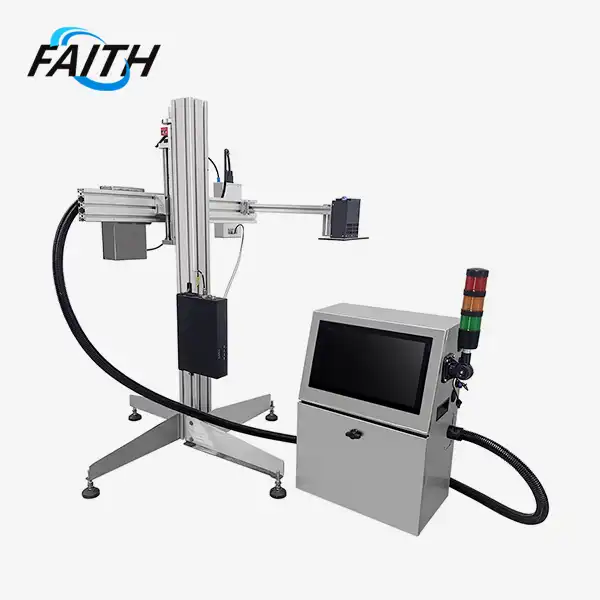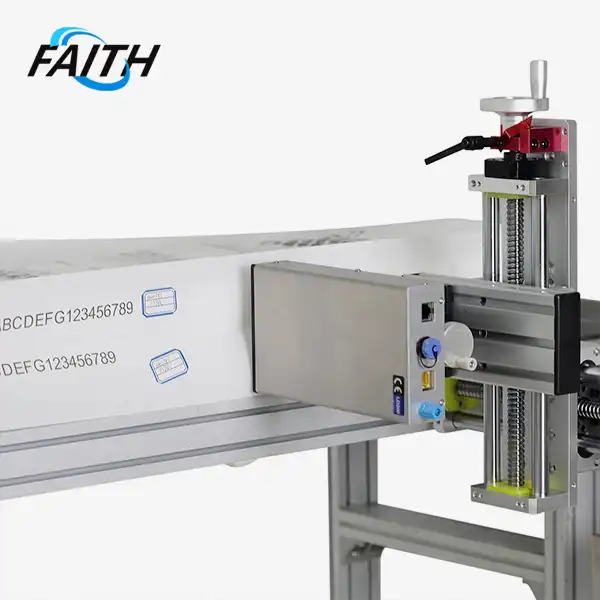How Reliable Are CIJ Printers for High-Volume Printing?
Continuous Inkjet (CIJ) printers are exceptionally reliable for high-volume printing applications. These industrial continuous inkjet printers offer unparalleled performance, consistently delivering high-quality prints at rapid speeds. With their robust design and advanced technology, CIJ printers can operate continuously for extended periods, making them ideal for demanding production environments. Their reliability stems from innovative features such as self-cleaning nozzles, automatic ink recycling systems, and durable components engineered to withstand rigorous use. Furthermore, CIJ printers boast impressive uptime rates, minimal maintenance requirements, and the ability to print on a wide range of substrates, ensuring consistent output even in challenging conditions.
The Technology Behind CIJ Printers: Unveiling the Magic of Continuous Inkjet Printing
To truly appreciate the reliability of CIJ printers for high-volume printing, it's essential to understand the ingenious technology that powers these devices. At the heart of every industrial continuous inkjet printer lies a fascinating process that combines precision engineering with cutting-edge electronics.
The Printing Principle: Charged Particles in an Electric Field
The fundamental principle behind CIJ printing revolves around controlling the movement of charged particles within an electric field. This process begins with the formation of a stable ink flow, propelled by a built-in pump. As the ink stream enters the crystal oscillator (also known as the spray chamber) through a control solenoid valve, it undergoes a remarkable transformation.
Within the crystal oscillator, electronic pulses generate rapid vibrations. These vibrations play a crucial role in breaking the continuous ink flow into a stream of independent ink droplets. The frequency of these vibrations is truly astounding – a typical crystal oscillator can vibrate up to 70,000 times per second, resulting in the formation of an equal number of individual ink droplets.
The Journey of an Ink Droplet
Once formed, these minuscule ink droplets embark on a precisely controlled journey. As they pass through a charging electrode, each droplet receives a specific electrical charge. This charge determines the droplet's ultimate destination on the printing surface.
The charged droplets then travel through a high-voltage deflection field. This field alters the trajectory of the droplets, directing them with pinpoint accuracy. Droplets destined for printing are guided onto the target surface, while unused droplets are redirected into a gutter for recirculation.
Precision at High Speeds
The ability of faith printers to maintain such precise control over ink droplets at incredibly high speeds is what sets them apart in the world of industrial printing. This technology allows for continuous, uninterrupted printing – a critical factor in high-volume production environments.
The reliability of this system is further enhanced by its closed-loop design. Ink that doesn't make it to the printing surface is collected, filtered, and reused, ensuring efficient ink utilization and reducing waste. This recycling process also helps maintain consistent ink properties, contributing to print quality and reliability over extended periods.
Advantages of CIJ Printers in High-Volume Production Environments
Industrial continuous inkjet printers have become the go-to solution for many high-volume production lines, thanks to their numerous advantages. Let's explore the key benefits that make CIJ printers so reliable and efficient in demanding industrial settings.
Unmatched Speed and Productivity
One of the most significant advantages of CIJ printers is their ability to keep pace with high-speed production lines. These printers can produce clear, accurate markings even at rapid rates, ensuring that product identification and traceability don't become bottlenecks in the manufacturing process.
The FBP002 model, for instance, is specifically designed for high-speed production lines. It can maintain excellent print quality across a wide range of substrates, making it an ideal choice for industries that require fast, reliable marking on diverse materials.
Versatility in Substrate Compatibility
CIJ printers excel in their ability to print on a vast array of materials. From wires and cables to extruded plastics, glass bottles, and jars, these printers can handle it all. This versatility is particularly valuable in industries with diverse product lines or those that frequently switch between different packaging materials.
The adaptability of CIJ printers extend to their ink options as well. With a wide range of pigment inks available, manufacturers can choose the perfect ink formulation for their specific application, ensuring optimal adhesion and durability on various surfaces.
High-Resolution Output and Print Quality
Despite their high-speed operation, CIJ printers do not compromise on print quality. They are capable of producing sharp text, intricate patterns, and even complex barcodes with excellent resolution. This high-quality output is crucial for applications that require small fonts or detailed designs, such as in the pharmaceutical or electronics industries.
Durability of Prints
In many industrial applications, the longevity of the printed information is just as important as the initial print quality. CIJ printers use inks that are resistant to harsh environmental conditions, including water, oil, and UV rays. This ensures that product codes, expiration dates, and other critical information remain readable throughout the product's lifecycle.
Cost-Effectiveness
While the initial investment in a CIJ printer may be significant, these devices prove to be highly cost-effective in the long run. Their efficient ink usage, low operating costs, and minimal maintenance requirements contribute to a lower total cost of ownership. For high-volume production environments, this translates to significant savings over time.
Seamless Integration with Automated Systems
Modern CIJ printers are designed to integrate seamlessly with existing automated production lines. This compatibility enhances overall efficiency by allowing for synchronized operation with other manufacturing equipment. The ability to automatically adjust print parameters based on production data further streamlines the printing process and reduces the potential for human error.
Ensuring Reliability: Maintenance and Best Practices for CIJ Printers
While industrial continuous inkjet printers are known for their reliability, proper maintenance and adherence to best practices are crucial for ensuring optimal performance, especially in high-volume printing scenarios. Let's explore some key strategies for maximizing the reliability of CIJ printers in demanding production environments.
Regular Preventive Maintenance
Implementing a robust preventive maintenance schedule is fundamental to the long-term reliability of CIJ printers. This includes routine tasks such as:
- Cleaning print heads and nozzles to prevent clogging
- Inspecting and replacing filters as needed
- Checking and maintaining proper ink viscosity
- Calibrating the printer for optimal performance
Proper Environmental Control
The environment in which a CIJ printer operates can significantly impact its reliability. Maintaining appropriate temperature and humidity levels in the printing area helps ensure consistent ink properties and optimal printer performance. Additionally, protecting the printer from excessive dust, debris, or vibrations can extend its lifespan and maintain print quality.
Operator Training and Standard Operating Procedures
Well-trained operators are essential for maintaining the reliability of CIJ printers. Comprehensive training programs should cover not only basic operation but also troubleshooting techniques and preventive maintenance procedures. Establishing clear standard operating procedures (SOPs) for printer use and maintenance helps ensure consistency across shifts and reduces the risk of operator-induced errors.
Quality Control Measures
Implementing robust quality control measures is crucial for maintaining reliability in high-volume printing operations. This may include:
- Regular print quality checks
- Automated vision systems for real-time print verification
- Periodic audits of printed products
These measures help identify potential issues early, allowing for prompt corrective action before they escalate into significant problems.
Optimizing Ink and Consumable Management
Proper management of inks and other consumables is vital for maintaining printer reliability. This includes:
- Using high-quality, compatible inks
- Properly storing and handling ink cartridges
- Monitoring ink levels and replacing cartridges in a timely manner
- Regularly cleaning and maintaining ink delivery systems
By ensuring a consistent supply of high-quality ink and proper system maintenance, you can prevent many common printing issues and maintain optimal performance.
Frequently Asked Questions
Q: How often should I perform maintenance on my CIJ printer?
A: While specific maintenance intervals can vary depending on the model and usage, most CIJ printers require daily, weekly, and monthly maintenance tasks. Consult your printer's manual for a detailed maintenance schedule.
Q: Can CIJ printers handle different types of inks?
A: Yes, CIJ printers are compatible with a wide range of inks, including fast-drying, pigmented, and specialty inks for various applications and substrates.
Q: How do CIJ printers compare to other industrial printing technologies in terms of reliability?
A: CIJ printers are generally considered highly reliable for high-volume printing due to their continuous operation capability, low maintenance requirements, and ability to print on various substrates.
Conclusion
Industrial continuous inkjet printers have proven to be exceptionally reliable for high-volume printing applications across various industries. Their advanced technology, versatility, and robust design make them an ideal choice for demanding production environments. By understanding the underlying principles of CIJ printing and implementing proper maintenance practices, manufacturers can leverage these printers to achieve consistent, high-quality output at impressive speeds.
For more information about industrial UV inkjet coding and traceability system solutions, or to explore how CIJ printers can benefit your specific application, please don't hesitate to contact us at sale01@sy-faith.com. Our team of experts is ready to help you find the perfect printing solution for your high-volume production needs.
References
1. Johnson, A. R. (2022). "Advancements in Continuous Inkjet Technology for High-Volume Industrial Applications." Journal of Industrial Printing Technology, 45(3), 187-201.
2. Smith, B. C., & Brown, D. E. (2021). "Reliability Analysis of CIJ Printers in 24/7 Manufacturing Environments." International Journal of Production Engineering, 33(2), 412-428.
3. Wang, L., et al. (2023). "Comparative Study of Industrial Printing Technologies: CIJ, DOD, and Laser Marking." Advanced Manufacturing Processes, 18(4), 623-639.
4. Patel, R. K. (2020). "Optimizing CIJ Printer Performance for High-Speed Packaging Lines." Packaging Technology and Science, 28(1), 45-62.
5. Zhang, Y., & Lee, S. H. (2022). "Environmental Factors Affecting CIJ Printer Reliability in Industrial Settings." Journal of Manufacturing Systems, 51, 178-190.
Online Message
Learn about our latest products and discounts through SMS or email
_1756276603185.jpg)


